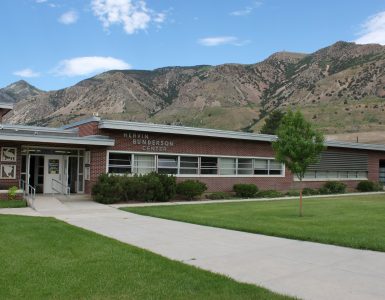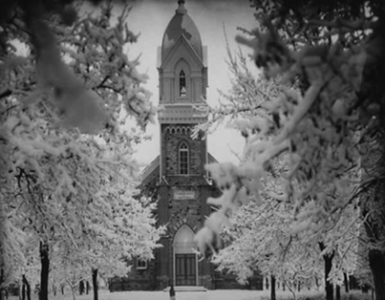Indian relations had been peaceful on the local scene, it was not so throughout the territory. Due to this concern, an order from Brigham Young, delivered in July 1853, by a Major Moore, urged the settlers to again move into a fort.
This second fort, called Box Elder Fort and later known as the “Old Fort,” was located about 3 blocks east and two blocks south of the Davis Fort. Its approximate southwest corner is now marked by a monument at 200 West and 300 North. This monument replaced a cornerstone dedicated on August 18, 1922, in the presence of some Old Fort veterans and a large gathering of people. In a signed statement, they noted:
‘. . .we assembled in the immediate vicinity of the ‘Old Fort’ and that after due consideration and discussion and unanimously located the southwest corner of the Old Fort and we marked the same corner with a stake, located under the direction of the officials of Brigham City. . .
The Old Fort was eight rods (132 feet) east and west, and twenty-five rods (412 feet) north and south, surrounded by log cabins with an entrance at the southwest corner, and an exit at the northeast corner.1Lydia Walker Forsgren, ed., History of Box Elder County, (Brigham City: Daughters of Utah Pioneers, 1937), 259.
The same signers also noted an addition to the fort, listing those who lived south of the west side, including “a Jew, unknown,” and south of the east side, which extended the fort another 300 feet on the open south end as more settlers arrived in 1854.
This enclosure was not a walled fort, but was formed by cabins built close together on the north, east, and west sides facing into a common area open on the south end with a smaller exit located at the northeast corner. Cabins were roomier and not adjoined, and water was diverted from Box Elder Creek into the fort so flooding common to the Davis Fort could be avoided.
Among the settlers who arrived in the fall of 1853 and wintered in the fort was a contingent of Scandinavian emigrants who had crossed the plains with John E. Forsgren, son-in-law of William Davis, whose wife and son had come to Box Elder with her parents while Elder Forsgren was serving a mission to Sweden in 1849-53. This Scandinavian company included Peter A. Forsgren, the first convert to Mormonism in Sweden, Jens Knudsen and family, Jens Olsen, and August Valentine, who hailed from Denmark. When Christine Erikka Forsgren (John E. Forsgren’s sister, who later married William Davis) arrived on October 11, 1853, she noted that there were about a dozen cabins already erected.2Olive H. Kotter, “Brigham City to 1900,” Through the Years, (Brigham City: Brigham City Eighth Ward, 1953), 8.
Converts from Wales also helped expand the settlement in 1853. One of the first Welsh families to arrive was that of David Hughes Peters, a cloth weaver who was accompanied by a number of his workers and their families. Although they started out living in the fort they soon moved onto land of their own, choosing an area on the border of what is now Brigham City and Perry (Three Mile Creek).3Fife, Veara S., and Chloe N. Petersen, Brigham City, Utah, Residents 1850,1877, (Brigham City: Golden Spike Chapter, Utah Geological Association, 1976), 19. John David Peters, a son of David Hughes Peters, described their first shelter as a “sort of wickyup” with poles in a slant position, then covered with willows, cane, and dirt, with one open end. He related the following story:
One day while mother was baking bread just in front of the shelter an Indian came along and asked for bread. Mother endeavored to show him that she had no bread but was just baking. He in a vicious way kicked the handle of the Dutch oven spilling coals from the lid and the dough into the ashes. Mother without saying a word went to the wagon box, which was covered and placed on stones as it was being used for a bed room, got a shotgun, when the Indian saw the gun he scampered in all haste.4Ibid., 19.
At the October 1853 Conference of the LDS Church in Salt Lake City, the bishop’s records showed there were 204 persons belonging to the church living on Box Elder Creek.5Nielson, Vaughn, and Church of Jesus Christ of Latter Day Saints, The History of Box Elder Stake: written in commemoration of the hundredth anniversary of Brigham Young’s setting in order a state for Box Elder County, (Brigham City: Box Elder Stake, 1977), 3. Nearly all of the settlers along Box Elder Creek, as did those in the Welsh settlement, moved into the fort for the winter of 1853-54 and some remained even longer, since it often served as temporary quarters for newcomers until they could build their own cabins. A listing of inhabitants and cabin numbers indicates 30-plus cabins, but considerably more family names.6Fife, Veara S., and Chloe N. Petersen, Brigham City, Utah, Residents 1850,1877, (Brigham City: Golden Spike Chapter, Utah Geological Association, 1976), 10-18.
Notes
Search Brigham City Museum Collections



Add comment